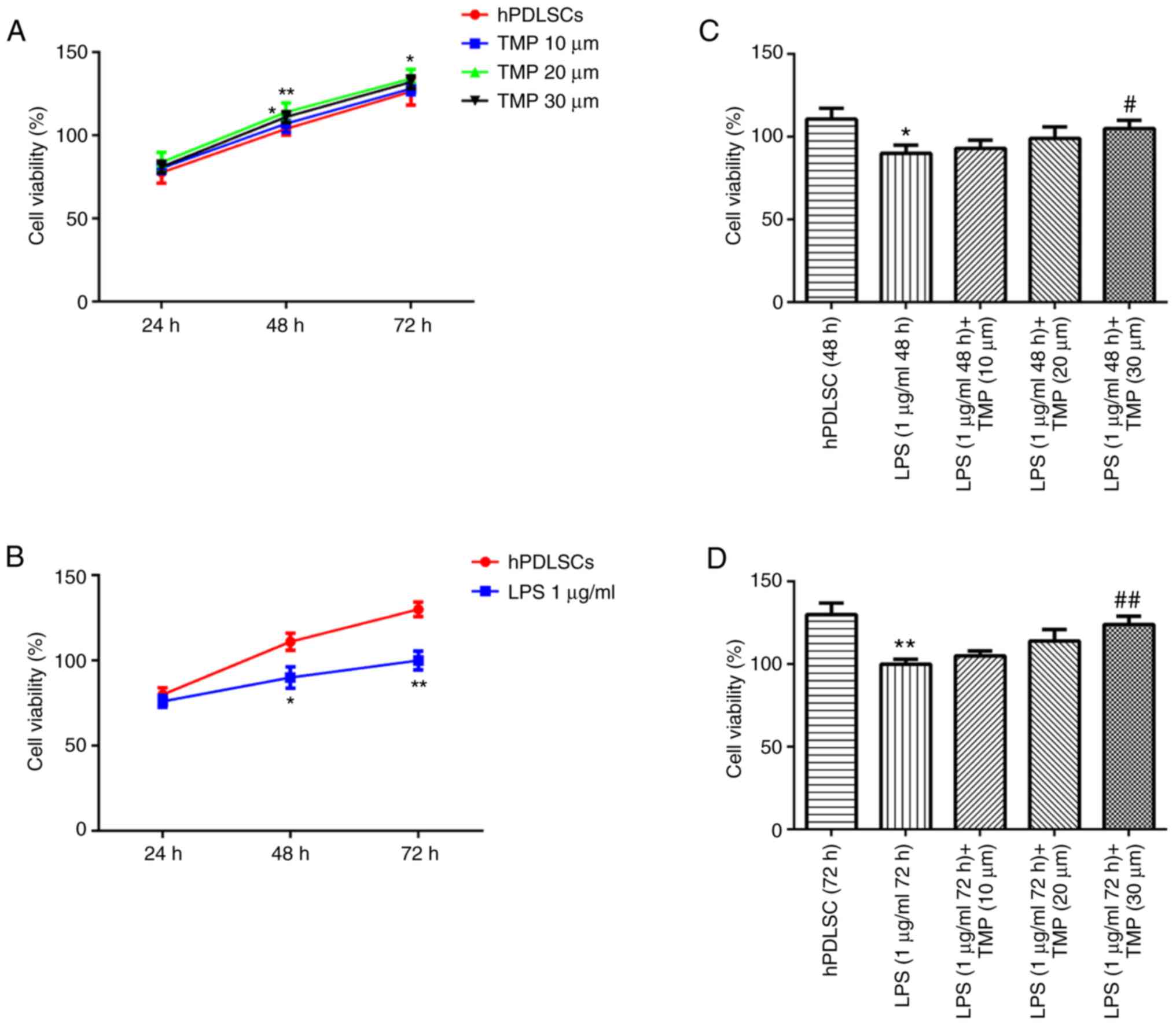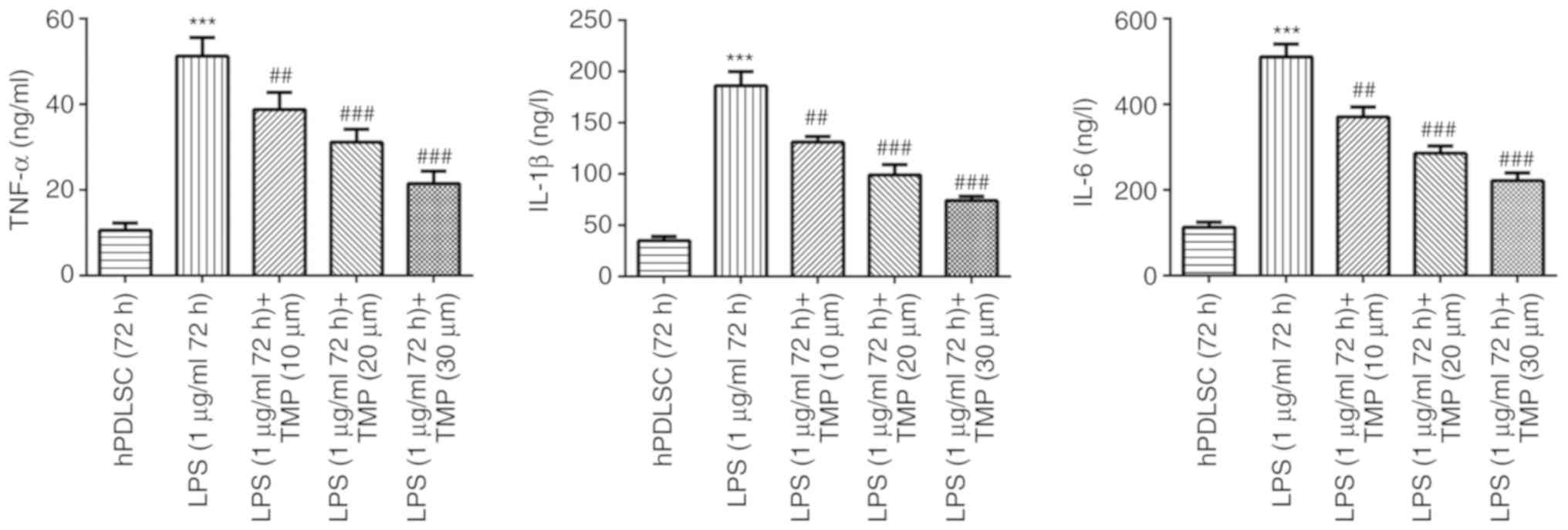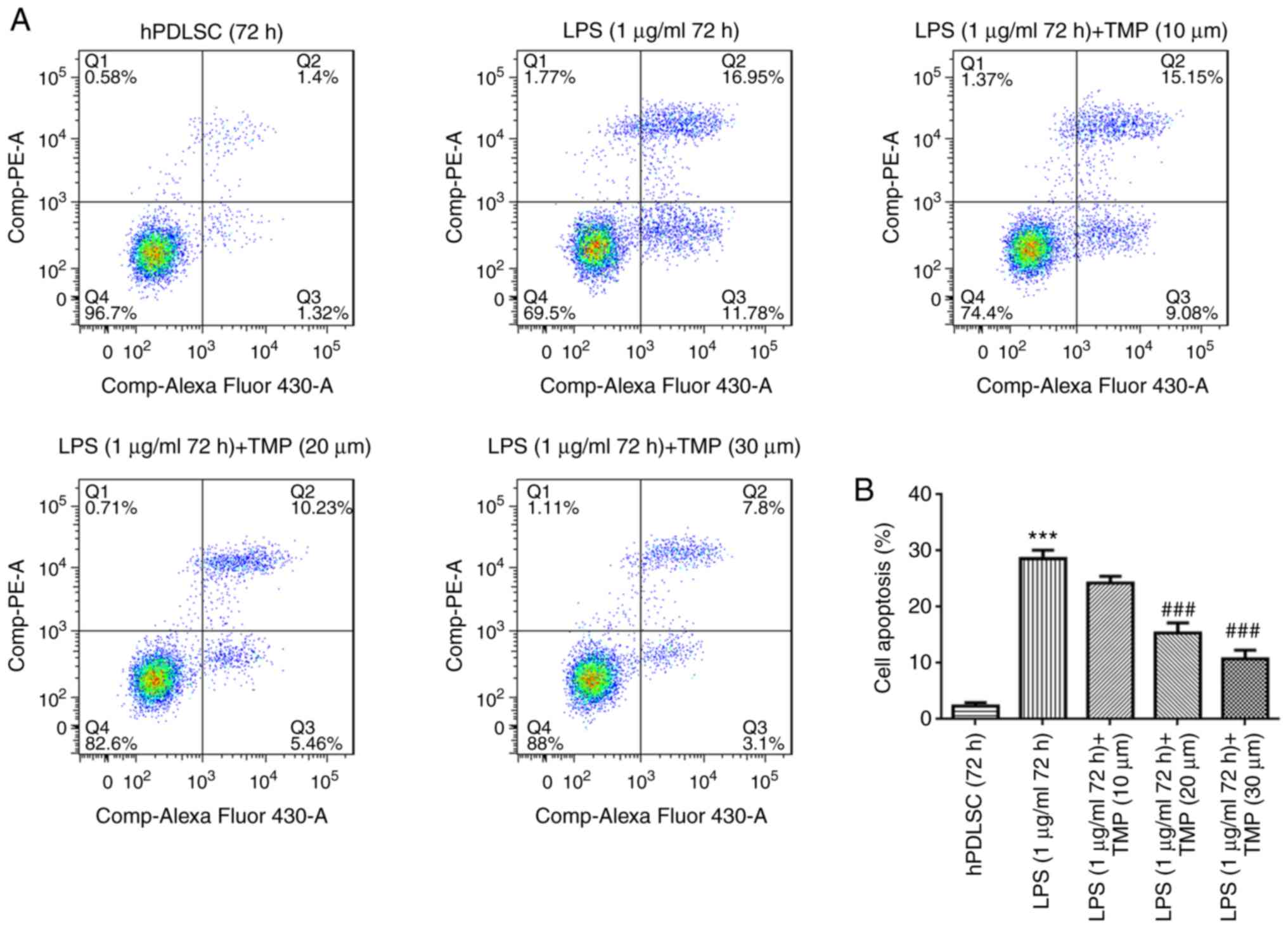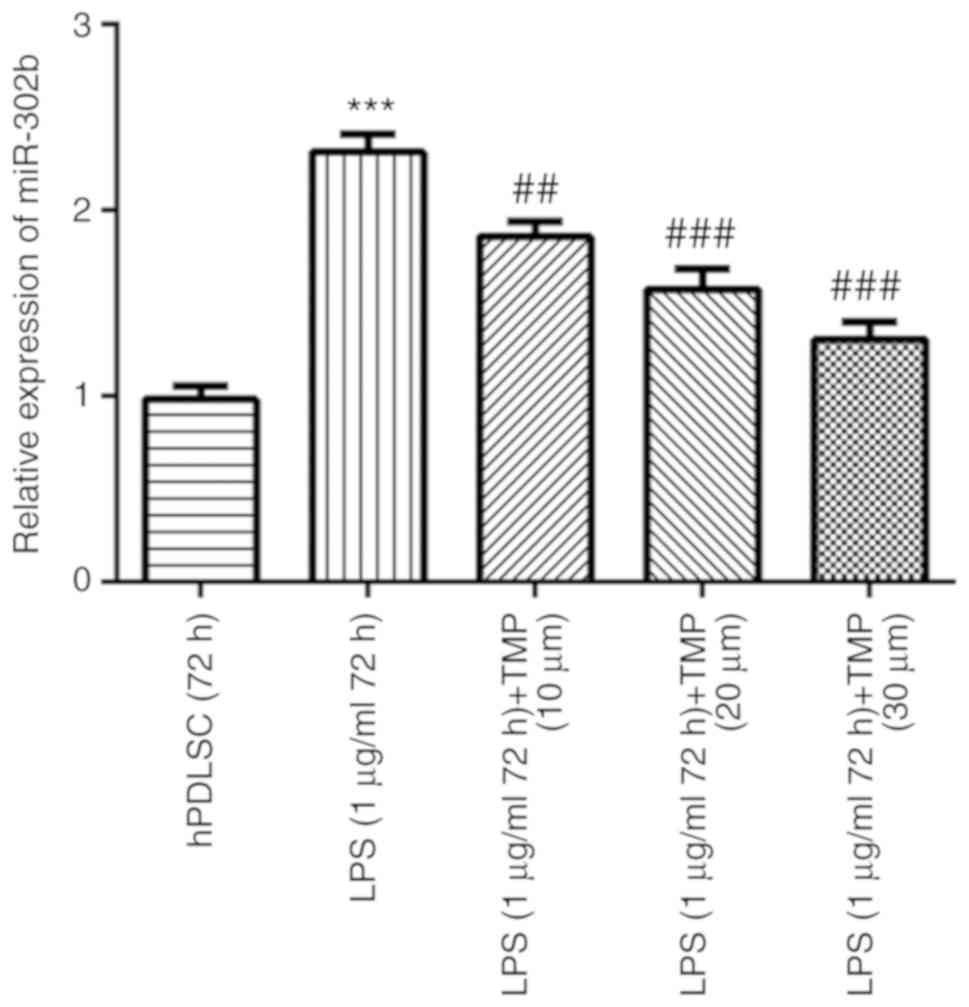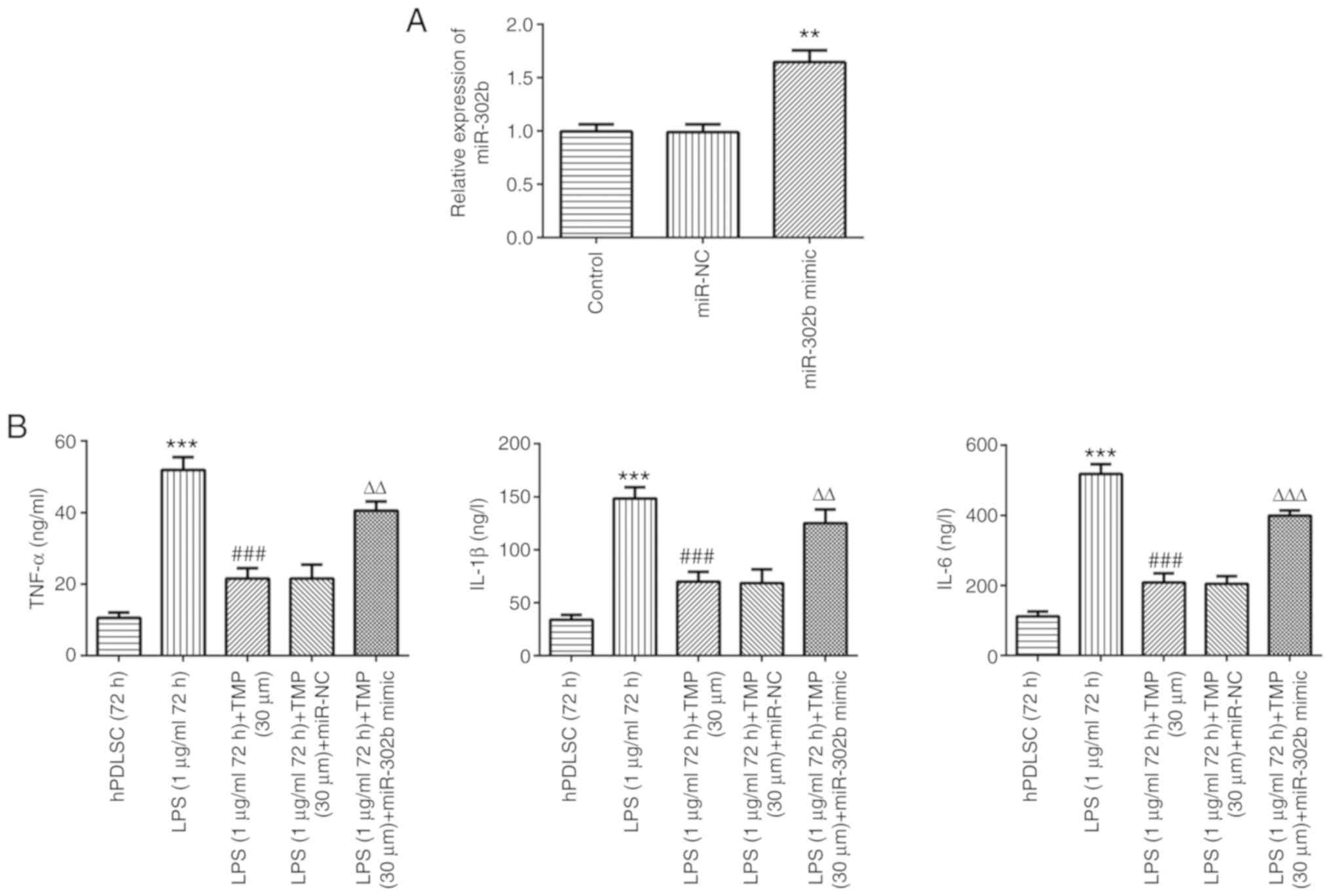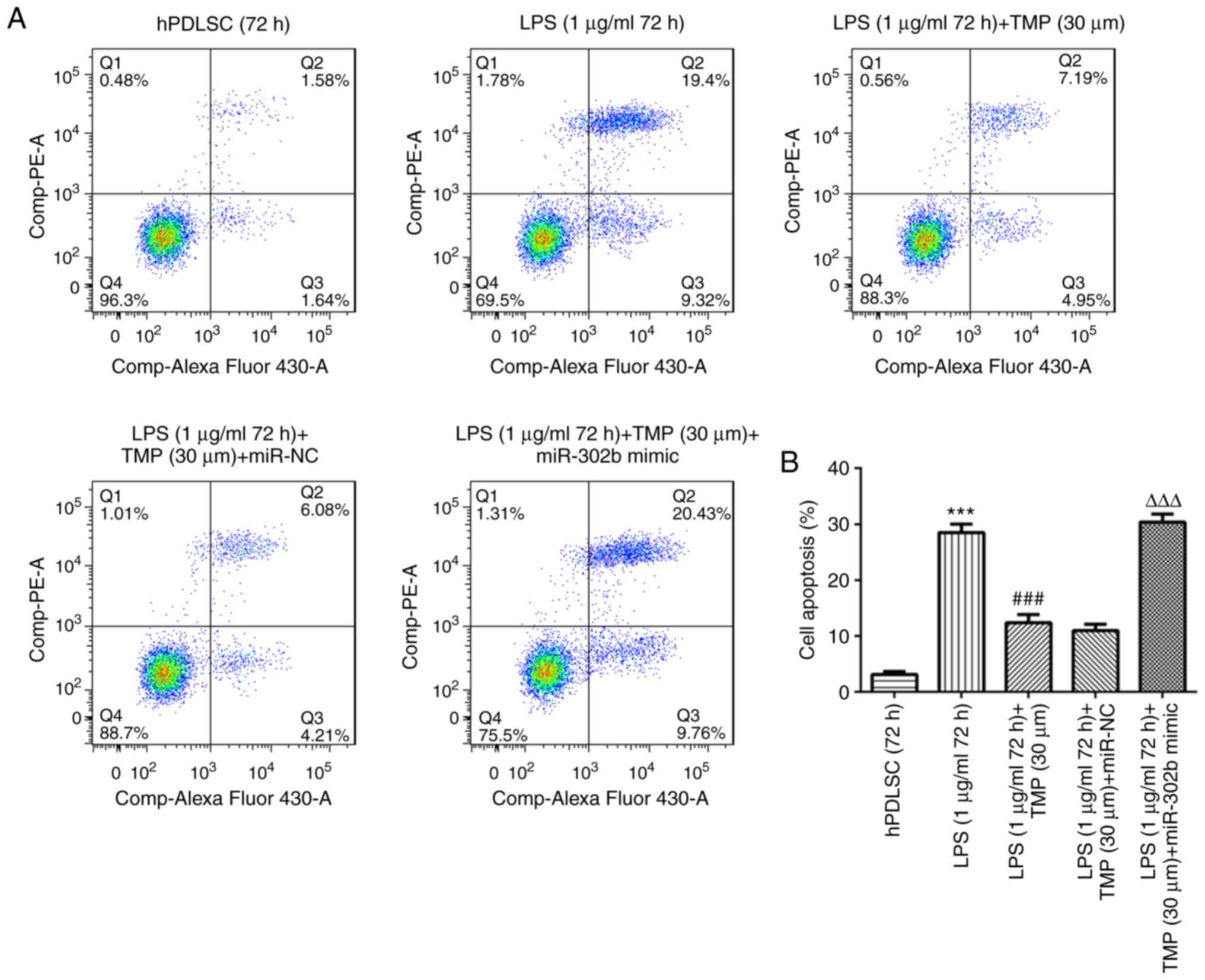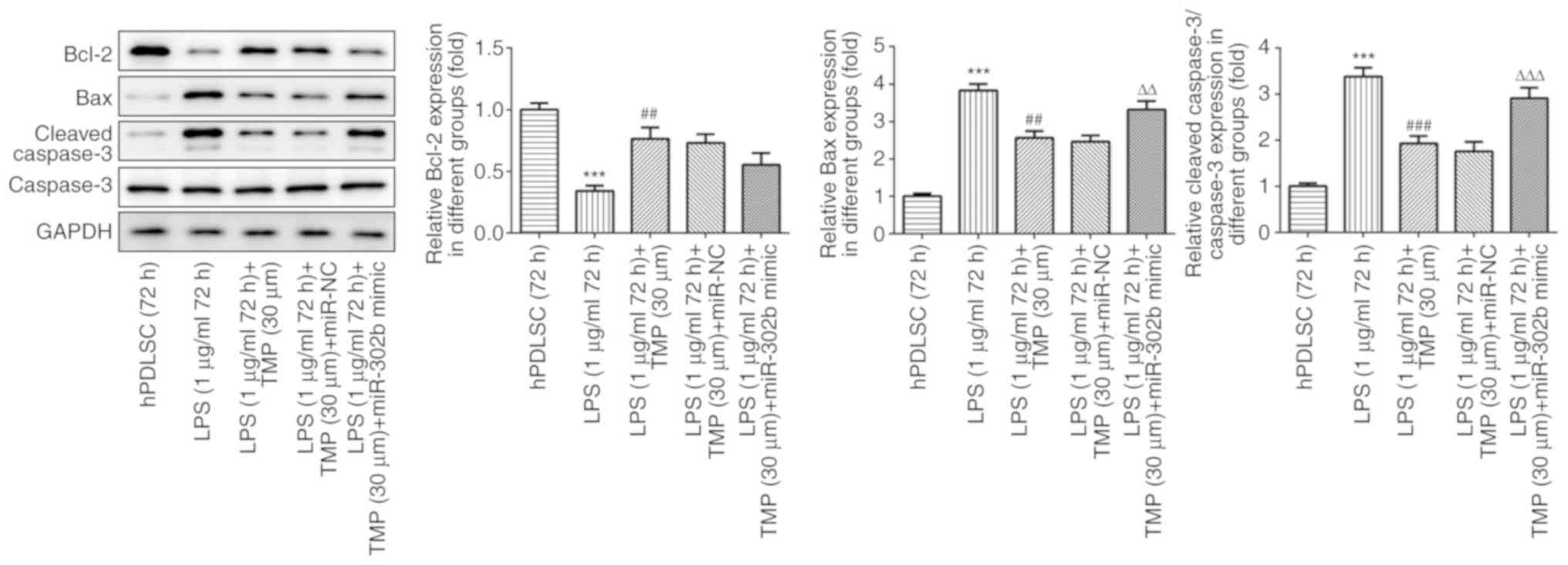|
1
|
Serrano C and Suarez E: Prevalence of
severe periodontitis in a colombian adult population. J Int Acad
Periodontol. 21:53–62. 2019.PubMed/NCBI
|
|
2
|
Zhang J, Zhang AM, Zhang ZM, Jia JL, Sui
XX, Yu LR and Liu HT: Efficacy of combined orthodontic-periodontic
treatment for patients with periodontitis and its effect on
inflammatory cytokines: A comparative study. Am J Orthod
Dentofacial Orthop. 152:494–500. 2017. View Article : Google Scholar : PubMed/NCBI
|
|
3
|
Ahmad N, Ahmad FJ, Bedi S, Sharma S, Umar
S and Ansari MA: A novel nanoformulation development of eugenol and
their treatment in inflammation and periodontitis. Saudi Pharm J.
27:778–790. 2019. View Article : Google Scholar : PubMed/NCBI
|
|
4
|
Czesnikiewicz-Guzik M, Osmenda G,
Siedlinski M, Nosalski R, Pelka P, Nowakowski D, Wilk G,
Mikolajczyk TP, Schramm-Luc A, Furtak A, et al: Causal association
between periodontitis and hypertension: Evidence from mende-lian
randomization and a randomized controlled trial of non-surgical
periodontal therapy. Eur Heart J. 40:3459–3470. 2019. View Article : Google Scholar : PubMed/NCBI
|
|
5
|
Wallace K, Shafique S and Piamjariyakul U:
The relationship between oral health and hemodialysis treatment
among adults with chronic kidney disease: A systematic review.
Nephrol Nurs J. 46:375–394. 2019.PubMed/NCBI
|
|
6
|
Zhou X, Zhang W, Liu X, Zhang W and Li Y:
Interrelationship between diabetes and periodontitis: Role of
hyperlipidemia. Arch Oral Biol. 60:667–674. 2015. View Article : Google Scholar
|
|
7
|
Franca LFC, Vasconcelos ACCG, da Silva
FRP, Alves EHP, Carvalho JS, Lenardo DD, de Souza LKM, Barbosa ALR,
Medeiros JR, de Oliveira JS and Vasconcelos DFP: Periodontitis
changes renal structures by oxidative stress and lipid
peroxidation. J Clin Periodontol. 44:568–576. 2017. View Article : Google Scholar : PubMed/NCBI
|
|
8
|
Trikka D and Vassilopoulos S: Periodontal
regeneration with enamel matrix derivative in the management of
generalized aggressive periodontitis: A case report with 11-year
follow-up and literature review. J Int Soc Prev Community Dent.
9:13–20. 2019. View Article : Google Scholar : PubMed/NCBI
|
|
9
|
Bella P and Istvan G: The comprehensive
periodontal, resorative end prosthodontic therapy of chronic
periodontitis case presentation. Fogorv Sz. 109:125–135. 2016.In
English, Hungarian. PubMed/NCBI
|
|
10
|
Ashouri Moghaddam A, Radafshar G,
Jahandideh Y and Kakaei N: Clinical evaluation of effects of local
application of aloe vera gel as an adjunct to scaling and root
planning in patients with chronic periodontitis. J Dent (Shiraz).
18:165–172. 2017.
|
|
11
|
Portron S, Soueidan A, Marsden AC, Rakic
M, Verner C, Weiss P, Badran Z and Struillou X: Periodontal
regenerative medicine using mesenchymal stem cells and
biomaterials: A systematic review of pre-clinical studies. Dent
Mater J. 38:867–883. 2019. View Article : Google Scholar : PubMed/NCBI
|
|
12
|
Son H, Jeon M, Choi HJ, Lee HS, Kim IH,
Kang CM and Song JS: Decellularized human periodontal ligament for
periodontium regeneration. PLoS One. 14:e02212362019. View Article : Google Scholar : PubMed/NCBI
|
|
13
|
Liu J, Yu F, Sun Y, Jiang B, Zhang W, Yang
J, Xu GT, Liang A and Liu S: Concise reviews: Characteristics and
potential applications of human dental tissue-derived mesenchymal
stem cells. Stem Cells. 33:627–638. 2015. View Article : Google Scholar
|
|
14
|
Nagata M, Iwasaki K, Akazawa K, Komaki M,
Yokoyama N, Izumi Y and Morita I: Conditioned medium from
periodontal ligament stem cells enhances periodontal regeneration.
Tissue Eng Part A. 23:367–377. 2017. View Article : Google Scholar :
|
|
15
|
Zheng DH, Wang XX, Ma D, Zhang LN, Qiao QF
and Zhang J: Erythropoietin enhances osteogenic differentiation of
human periodontal ligament stem cells via Wnt/β-catenin signaling
pathway. Drug Des Devel Ther. 13:2543–2552. 2019. View Article : Google Scholar :
|
|
16
|
Gu K, Fu X, Tian H, Zhang Y, Li A, Wang Y,
Wen Y and Gu W: TAZ promotes the proliferation and osteogenic
differentiation of human periodontal ligament stem cells via the
p-SMAD3. J Cell Biochem. 121:1101–1113. 2020. View Article : Google Scholar
|
|
17
|
Menicanin D, Mrozik KM, Wada N, Marino V,
Shi S, Bartold PM and Gronthos S: Periodontal-ligament-derived stem
cells exhibit the capacity for long-term survival, self-renewal,
and regeneration of multiple tissue types in vivo. Stem Cells Dev.
23:1001–1011. 2014. View Article : Google Scholar :
|
|
18
|
Li J, Li Y, Pan S, Zhang L, He L and Niu
Y: Paeonol attenuates ligation-induced periodontitis in rats by
inhibiting osteoclasto-genesis via regulating Nrf2/NF-κB/NFATc1
signaling pathway. Biochimie. 156:129–137. 2019. View Article : Google Scholar
|
|
19
|
Zhou W, Su L, Duan X, Chen X, Hays A,
Upadhyayula S, Shivde J, Wang H, Li Y, Huang D and Liang S:
MicroRNA-21 down-regulates inflammation and inhibits periodontitis.
Mol Immunol. 101:608–614. 2018. View Article : Google Scholar : PubMed/NCBI
|
|
20
|
Elburki MS, Rossa C Jr, Guimarães-Stabili
MR, Lee HM, Curylofo-Zotti FA, Johnson F and Golub LM: A chemically
modified curcumin (CMC 2.24) inhibits nuclear factor κB activation
and inflammatory bone loss in murine models of LPS-induced
experimental periodontitis and diabetes-associated natural
periodontitis. Inflammation. 40:1436–1449. 2017. View Article : Google Scholar : PubMed/NCBI
|
|
21
|
Li F and Xu HS: Effects of low level laser
combined with basic periodontal therapy on cytokines and LPS,
leptin in gingival crevicular fluid of diabetes mellitus
complicated with chronic periodontitis patients. Shanghai Kou Qiang
Yi Xue. 27:637–640. 2018.In Chinese.
|
|
22
|
Wei S, Chi J, Zhou M, Li R, Li Y, Luo J
and Kong L: Anti-inflammatory lindenane sesquiterpeniods and dimers
from Sarcandra glabra and its upregulating AKT/Nrf2/HO-1 signaling
mechanism. Industrial Crops and Products. 137:367–376. 2019.
View Article : Google Scholar
|
|
23
|
Zhou J, Xu G, Yan J, Li K, Bai Z, Cheng W
and Huang K: Rehmannia glutinosa (Gaertn.) DC. polysaccharide
ameliorates hyperglycemia, hyperlipemia and vascular inflammation
in streptozotocin-induced diabetic mice. J Ethnopharmacol.
164:229–238. 2015. View Article : Google Scholar : PubMed/NCBI
|
|
24
|
Chen X, Yi L, Song S, Wang L, Liang Q,
Wang Y, Wu Y and Gao Q: Puerarin attenuates palmitate-induced
mitochondrial dysfunction, impaired mitophagy and inflammation in
L6 myotubes. Life Sci. 206:84–92. 2018. View Article : Google Scholar : PubMed/NCBI
|
|
25
|
Dong J, Liang W, Wang T, Sui J, Wang J,
Deng Z and Chen D: Saponins regulate intestinal inflammation in
colon cancer and IBD. Pharmacol Res. 144:66–72. 2019. View Article : Google Scholar : PubMed/NCBI
|
|
26
|
Michel HE and Menze ET:
Tetramethylpyrazine guards against cisplatin-induced nephrotoxicity
in rats through inhibiting HMGB1/TLR4/NF-κB and activating Nrf2 and
PPAR-γ signaling pathways. Eur J Pharmacol. 857:1724222019.
View Article : Google Scholar
|
|
27
|
Fan L, Wang K, Shi Z, Die J, Wang C and
Dang X: Tetramethylpyrazine protects spinal cord and reduces
inflammation in a rat model of spinal cord ischemia-reperfusion
injury. J Vasc Surg. 54:192–200. 2011. View Article : Google Scholar : PubMed/NCBI
|
|
28
|
Chen J, Wang H, Gao C, Liu D, Fan Y, Li W,
Chen Y and Pan S: Tetramethylpyrazine alleviates LPS-induced
inflammatory injury in HUVECs by inhibiting Rho/ROCK pathway.
Biochem Biophys Res Commun. 514:329–335. 2019. View Article : Google Scholar : PubMed/NCBI
|
|
29
|
Kao TK, Chang CY, Ou YC, Chen WY, Kuan YH,
Pan HC, Liao SL, Li GZ and Chen CJ: Tetramethylpyrazine reduces
cellular inflammatory response following permanent focal cerebral
ischemia in rats. Exp Neurol. 247:188–201. 2013. View Article : Google Scholar : PubMed/NCBI
|
|
30
|
Liao SL, Kao TK, Chen WY, Lin YS, Chen SY,
Raung SL, Wu CW, Lu HC and Chen CJ: Tetramethylpyrazine reduces
ischemic brain injury in rats. Neurosci Lett. 372:40–45. 2004.
View Article : Google Scholar : PubMed/NCBI
|
|
31
|
Ge T, Yin M, Yang M, Liu T and Lou G:
MicroRNA-302b suppresses human epithelial ovarian cancer cell
growth by targeting RUNX1. Cell Physiol Biochem. 34:2209–2220.
2014. View Article : Google Scholar
|
|
32
|
Lazar V, Saviuc CM and Chifiriuc MC:
Periodontitis and periodontal disease-innovative strategies for
reversing the chronic infectious and inflammatory condition by
natural products. Curr Pharm Des. 22:230–237. 2016. View Article : Google Scholar
|
|
33
|
Jia R, Yi Y, Liu J, Pei D, Hu B, Hao H, Wu
L, Wang Z, Luo X and Lu Y: Cyclic compression emerged dual effects
on the osteogenic and osteoclastic status of LPS-induced
inflammatory human periodontal ligament cells according to loading
force. BMC Oral Health. 20:72020. View Article : Google Scholar : PubMed/NCBI
|
|
34
|
Duan Y, An W, Wu H and Wu Y: Salvianolic
acid C attenuates LPS-induced inflammation and apoptosis in human
periodontal ligament stem cells via toll-like receptors 4
(TLR4)/nuclear factor kappa B (NF-κB) pathway. Med Sci Monit.
25:9499–9508. 2019. View Article : Google Scholar : PubMed/NCBI
|
|
35
|
Wang L, Xia J, Liu Q and Jin Y: Effect of
lipopolysaccharide on proliferation and inflammatory factors
expression of human periodontal ligament stem cells. Hua Xi Kou
Qiang Yi Xue Za Zhi. 31:286–290. 2013.In Chinese. PubMed/NCBI
|
|
36
|
Yu Y, Bi CS, Wu RX, Yin Y, Zhang XY, Lan
PH and Chen FM: Effects of short-term inflammatory and/or hypoxic
pretreatments on periodontal ligament stem cells: In vitro and in
vivo studies. Cell Tissue Res. 366:311–328. 2016. View Article : Google Scholar : PubMed/NCBI
|
|
37
|
Tang HN, Xia Y, Yu Y, Wu RX, Gao LN and
Chen FM: Stem cells derived from 'inflamed' and healthy periodontal
ligament tissues and their sheet functionalities: A patient-matched
comparison. J Clin Periodontol. 43:72–84. 2016. View Article : Google Scholar : PubMed/NCBI
|
|
38
|
Guan D, Su Y, Li Y, Wu C, Meng Y, Peng X
and Cui Y: Tetramethylpyrazine inhibits CoCl2-induced neurotoxicity
through enhancement of Nrf2/GCLc/GSH and suppression of
HIF1α/NOX2/ROS pathways. J Neurochem. 134:551–565. 2015. View Article : Google Scholar : PubMed/NCBI
|
|
39
|
Wu X, Zhang F, Xiong X, Lu C, Lian N, Lu Y
and Zheng S: Tetramethylpyrazine reduces inflammation in liver
fibrosis and inhibits inflammatory cytokine expression in hepatic
stellate cells by modulating NLRP3 inflammasome pathway. IUBMB
Life. 67:312–321. 2015. View
Article : Google Scholar : PubMed/NCBI
|
|
40
|
Zhao H, Xu ML, Zhang Q, Guo ZH, Peng Y, Qu
ZY and Li YN: Tetramethylpyrazine alleviated cytokine synthesis and
dopamine deficit and improved motor dysfunction in the mice model
of Parkinson's disease. Neurol Sci. 35:1963–1967. 2014. View Article : Google Scholar : PubMed/NCBI
|
|
41
|
Guo M, Liu Y and Shi D: Cardiovascular
actions and therapeutic potential of tetramethylpyrazine (Active
Component Isolated from Rhizoma Chuanxiong): Roles and mechanisms.
Biomed Res Int. 2016:24303292016. View Article : Google Scholar : PubMed/NCBI
|
|
42
|
Hu JZ, Wang XK, Cao Y, Li DZ, Wu TD, Zhang
T, Xu DQ and Lu HB: Tetramethylpyrazine facilitates functional
recovery after spinal cord injury by inhibiting MMP2, MMP9, and
vascular endothelial cell apoptosis. Curr Neurovasc Res.
14:110–116. 2017. View Article : Google Scholar : PubMed/NCBI
|
|
43
|
Bi L, Yan X, Chen W, Gao J, Qian L and Qiu
S: Antihepatocellular carcinoma potential of tetramethylpyrazine
induces cell cycle modulation and mitochondrial-dependent
apoptosis: Regulation of p53 signaling pathway in HepG2 cells in
vitro. Integr Cancer Ther. 15:226–236. 2016. View Article : Google Scholar : PubMed/NCBI
|
|
44
|
Lin KH, Kuo WW, Jiang AZ, Pai P, Lin JY,
Chen WK, Day CH, Shen CY, Padma VV and Huang CY:
Tetramethylpyrazine ameliorated hypoxia-induced myocardial cell
apoptosis via HIF-1α/JNK/p38 and IGFBP3/BNIP3 inhibition to
upregulate PI3K/Akt survival signaling. Cell Physiol Biochem.
36:334–344. 2015. View Article : Google Scholar
|
|
45
|
Fang Y, Chu L, Li L, Wang J, Yang Y, Gu J
and Zhang J: Tetramethylpyrazine protects bone marrow-derived
mesenchymal stem cells against hydrogen peroxide-induced apoptosis
through PI3K/Akt and ERK1/2 pathways. Biol Pharm Bull.
40:2146–2152. 2017. View Article : Google Scholar : PubMed/NCBI
|
|
46
|
Wang Y, Yu T, Jin H, Zhao C and Wang Y:
Knockdown MiR-302b alleviates LPS-induced injury by targeting smad3
in C28/I2 chondrocytic cells. Cell Physiol Biochem. 45:733–743.
2018. View Article : Google Scholar : PubMed/NCBI
|















